
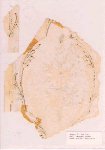
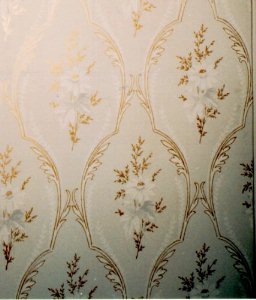
Stuart Stark, trying to discover the original wall covering in the Parlour, used an ultra-violet light on the wall. It revealed the shapes in the pattern of the original wallpaper etched in the plaster, but it could not provide the colours in the paper. Using the colours suggested by Stark, a reproduction of the wallpaper was produced by Bradbury & Bradbury Art Wallpapers. Some time later, an example turned up of the original wallpaper that was retrieved by Peter Cotton, which was thought to be lost, and affirmed the colour choice was correct.
Go to the Parlour room wallpaper page to see the many layers of wallpaper recovered from the Parlour.
See the present day wallpaper.
 The wallpaper in the Foyer was found to be a marbleized wallpaper, hidden under the Foyer's painted finish. A similar wall paper was applied in the same block-like arrangement, which was popular during the time and the original arrangement for the house.
The wallpaper in the Foyer was found to be a marbleized wallpaper, hidden under the Foyer's painted finish. A similar wall paper was applied in the same block-like arrangement, which was popular during the time and the original arrangement for the house.
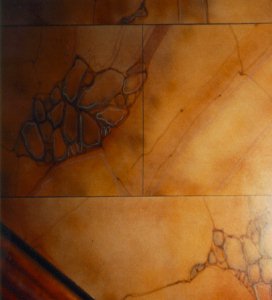 Marbleized Wallpapers
Marbleized Wallpapers
"Marblized wallpapers, with their counterparts 'granite' papers were popular in homes for the air of solidity that they imparted.
There were two main methods of hanging marble papers. As the pattern, of necessity, forms into blocks, marble papers sometimes were manufactured and hung in 'blocks'. This was an especially useful device when this wallpaper was open to wear and damage from moving funiture up and down stairs for example. When damaged a new 'block' of wallpaper was applied as a repair.
The second method of hanging marble papers was to hang 'horizontally, and lined to sized blocks with brown lines (or black pencil), twice sized, and varnished (once or twice) with best copal' (Encyclopaedia of Architecture, 1867).
This horizontal hanging method was the one used in the Carr House..."
(from Report on Interior Site Investigation of the Principal Rooms of the Richard Carr Houseby Stuart Stark)
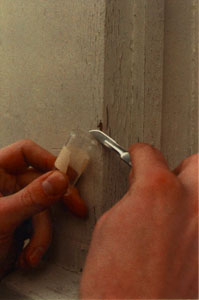 The layers of paint and wallpaper were stripped down, both mechanically and chemically, to find the original colour of paint used in the rooms. Small samples of paint are studied carefully, sometimes under a microscope, to determine the exact colour of the original paint. A surprisingly vibrant blue colour was found to be the original colour in the breakfast room, but it can not be proved if that colour remained for some time or if it was only a base coat (seen below).
The layers of paint and wallpaper were stripped down, both mechanically and chemically, to find the original colour of paint used in the rooms. Small samples of paint are studied carefully, sometimes under a microscope, to determine the exact colour of the original paint. A surprisingly vibrant blue colour was found to be the original colour in the breakfast room, but it can not be proved if that colour remained for some time or if it was only a base coat (seen below).

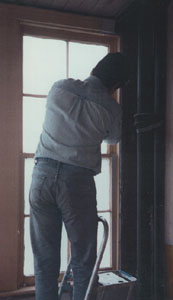 The indoor bathroom was added to the house in 1865, and careful investigation of the room revealed the inside walls were made from tongue and groove siding. The original position of the bathroom fixtures were found from the holes in the siding, and proved there was originally no toilet in the bathroom.
The indoor bathroom was added to the house in 1865, and careful investigation of the room revealed the inside walls were made from tongue and groove siding. The original position of the bathroom fixtures were found from the holes in the siding, and proved there was originally no toilet in the bathroom.
In The Book of Small, Emily says,
"Father built a beautiful bathroom. Two sides of it were glass. It was built over the verandah and he trained his grape-vine round the windows."
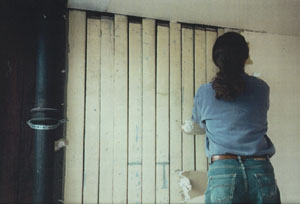 The windows were restored and stabilized to their original condition as suggested by this quotation and the existing structure.
The windows were restored and stabilized to their original condition as suggested by this quotation and the existing structure.
Click on the images below to see some of the wall surfaces during renovations.
(43K)
 (33K)
(33K)
(40K)
 (46K)
(46K)
 Return to restoration main page.
Return to restoration main page.

Last updated: 03 August 1997
Sponsored by: Industry Canada 
Produced by: Schoolnet Digital Collections Team
Content provided by: BC Heritage Branch, Province of British Columbia
 The wallpaper in the Foyer was found to be a marbleized wallpaper, hidden under the Foyer's painted finish. A similar wall paper was applied in the same block-like arrangement, which was popular during the time and the original arrangement for the house.
The wallpaper in the Foyer was found to be a marbleized wallpaper, hidden under the Foyer's painted finish. A similar wall paper was applied in the same block-like arrangement, which was popular during the time and the original arrangement for the house.



 The layers of paint and wallpaper were stripped down, both mechanically and chemically, to find the original colour of paint used in the rooms. Small samples of paint are studied carefully, sometimes under a microscope, to determine the exact colour of the original paint. A surprisingly vibrant blue colour was found to be the original colour in the breakfast room, but it can not be proved if that colour remained for some time or if it was only a base coat (seen below).
The layers of paint and wallpaper were stripped down, both mechanically and chemically, to find the original colour of paint used in the rooms. Small samples of paint are studied carefully, sometimes under a microscope, to determine the exact colour of the original paint. A surprisingly vibrant blue colour was found to be the original colour in the breakfast room, but it can not be proved if that colour remained for some time or if it was only a base coat (seen below).
 The indoor bathroom was added to the house in 1865, and careful investigation of the room revealed the inside walls were made from tongue and groove siding. The original position of the bathroom fixtures were found from the holes in the siding, and proved there was originally no toilet in the bathroom.
The indoor bathroom was added to the house in 1865, and careful investigation of the room revealed the inside walls were made from tongue and groove siding. The original position of the bathroom fixtures were found from the holes in the siding, and proved there was originally no toilet in the bathroom. The windows were restored and stabilized to their original condition as suggested by this quotation and the existing structure.
The windows were restored and stabilized to their original condition as suggested by this quotation and the existing structure.







